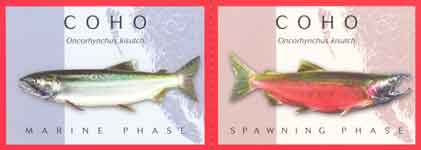|
|
|
|
SALMON SPAWNER SURVEYS
| |
|
Annual Spawner Surveys began in 1995.
Originally, the designated survey areas covered only a small section of Mosquito Creek and Thain Creek. However, those areas included important habitat and access routes, which could provide a good sample of fish presence from year to year.
The same areas were surveyed from 1995 through 1999.
In 1998, 1999, 2000 and 2003, newly constructed restoration projects allowed salmon access to more habitat, and the survey areas were adjusted accordingly.
The survey continued through 2005, and 2006.
| |
|
Adult spawners and redds were counted. Other fish were not included in the count.
Random spawner sightings were recorded but not included in the survey total.
Fell Channel and Griffin Channel were also monitored during spawning season.
| |
| |
The survey areas are now checked each Fall to be certain there are no obstacles or other problems for spawners entering the stream.
| |
| |
In 2011, one live spawner was seen at the fish ladder on December 4, and one spawner carcass was found just downstream of the Thain confluence in late December.
| |
| |
See ASSESSMENT for Fish Count projects.
|
|
|

| |
| |
Illustration Courtesy of Fisheries and Oceans Canada
|
|
| |
IMPACT OF HABITAT RESTORATION
| |
| |
Spawning options for salmon changed in 1998, when the Griffin Channel was constructed. New additional habitat was suddenly available, and two pairs of Coho spawned there that year. The following year, 1999, three pairs of Coho spawned at Griffin.
| |
| |
In 1999, the Thain Creek culvert was daylighted, allowing salmon and steelhead access to another 300 meters of stream.
| |
| |
In 1999-2000, the Fell Channel was constructed, providing more new spawning and rearing habitat.
| |
| |
In 2003, fish baffles and a ladder were added to the Queens culvert, allowing salmon access to more habitat upstream.
| |
|
From a fish viewpoint this was great. From a survey viewpoint, this resulted in more places for salmon to be, outside of the survey zone.
Short-term, there will probably be fewer spawners in the original survey zone, as they spread out to take advantage of new habitat.
Long-term, as populations increase, there should be more.
| |
|
|
|

